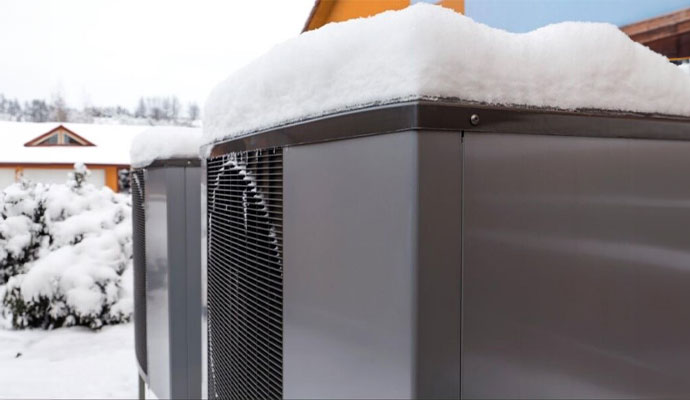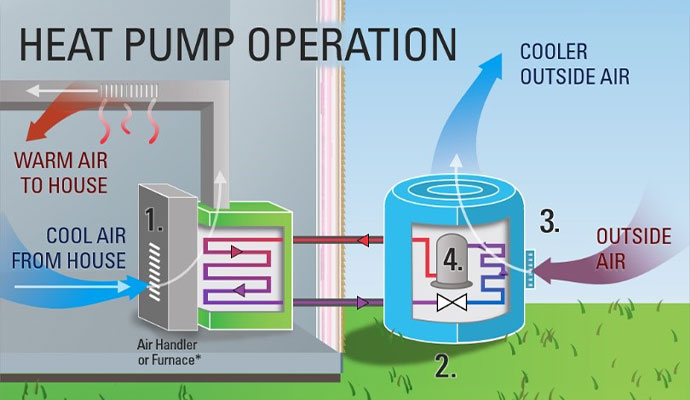How Does a Heat Pump Heat Your Home? And How to Know When Something is Wrong.
When winter’s chill sets in, keeping your home warm and comfortable is essential. Many homeowners rely on heat pumps to do the job. But how exactly do heat pumps work to heat your home, and what should you watch for to know if something’s going wrong with your system?
How a Heat Pump Heats Your Home

When outdoor temperatures fall, the air naturally holds less moisture. Combine that with indoor heating systems, which further strip moisture from the air, and you’re left with a home environment that can feel uncomfortably dry.
A heat pump is an efficient and versatile heating and cooling system. Unlike traditional furnaces that burn fuel to generate heat, heat pumps move heat from one place to another. In the winter, heat pumps extract heat from the outside air (even when it's cold) and move it inside to warm your home. Here's how it works in a simple step-by-step process:
- Evaporator Coil Absorbs Heat: The heat pump contains a refrigerant that circulates through the evaporator coil, located outside your home. Even in cold temperatures, there is still heat in the air, and the refrigerant absorbs this heat.
- Compression of the Refrigerant: The absorbed heat is transferred to the refrigerant, which is then compressed in the compressor. Compression increases the temperature of the refrigerant, making it hot enough to warm your home.
- Heat Exchange Inside Your Home: The hot refrigerant is sent inside, where it passes through the condenser coil. As the refrigerant releases its heat, warm air is blown into your home via ductwork or a fan, raising the indoor temperature to your desired level.
- Circulation of Air: Once the warm air circulates through your home, the refrigerant cools down and returns to the outside coil, where the process starts over again.
This continuous transfer of heat allows the heat pump to maintain a comfortable indoor temperature without the need for combustion, which makes it an energy-efficient option for many homeowners.
When to Know Something is Wrong with Your Heat Pump

Heat pumps are durable, but like all mechanical systems, they can experience issues over time. Recognizing when something is wrong with your heat pump early can save you from costly repairs and ensure your home stays warm. Here are some signs that your heat pump may need attention:
- Inadequate Heating or Cooling: If your heat pump isn’t effectively warming your home, it may be an indication of a refrigerant leak, a malfunctioning thermostat, or an issue with the compressor. This can lead to poor performance, so it’s important to get the system checked.
- Strange Noises: Heat pumps should operate relatively quietly. If you hear strange noises like banging, rattling, or grinding, there could be a mechanical issue, such as a loose part or a failing motor.
- Ice Buildup on the Outdoor Unit: It’s normal for a little frost to form on the outdoor unit during colder weather, but if ice builds up excessively, it can prevent the heat pump from functioning properly. This could signal a problem with the defrost cycle or low refrigerant levels.
- Poor Airflow: Weak or insufficient airflow can be caused by a clogged air filter, a problem with the fan, or blocked ductwork. Make sure to regularly change your air filters and inspect your ducts for blockages.
- Short Cycling: If your heat pump turns on and off frequently without reaching the desired temperature, it may be experiencing issues with the thermostat, a clogged filter, or a malfunctioning compressor.
- High Utility Bills: If your energy bills spike unexpectedly, it could be a sign that your heat pump is working harder than it should. Inefficiencies in the system, such as low refrigerant, dirty coils, or worn-out components, can lead to higher energy consumption.
- Foul Odors: Unpleasant smells coming from the heat pump could indicate mold or mildew buildup in the system, which can occur if moisture gets trapped inside. This is a problem that requires professional attention to clean and address the underlying cause.
When to Call a Professional
If you notice any of the issues mentioned above, it’s crucial to have your heat pump inspected by a qualified technician. At Riverside Heating & Air Conditioning, our experienced professionals are here to help keep your system running smoothly. Regular maintenance is key to preventing problems before they arise and ensuring your heat pump operates efficiently all winter long. Trust Riverside to keep your home warm and worry-free!


